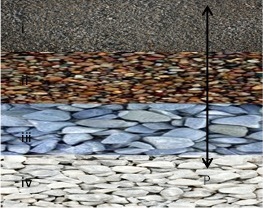=========================================================================================================
I.
Calculating
the geostatic stress at a point, P, below the ground. Use
Figure 3 as a reference.

Figure 3.

Figure 3.
There are four
different layers (strata) of soil in Figure 3. Each one is labled
individualy, i, ii, iii, iv. Table 1 will give the neseccary
information for each of the soil layers.
The location of P is 3m below layer iii.
With the given information the stress at P is equal to 18.1*5 + 17.8*5 + 17.4*5 + 17.6*(5-2) [(kN/m^3)(m)].
Calculating this out, σ1 = 319.9kPa.
II. After lab testing of a core sample of P, σ3 was set to 100kPa, which yeilded a failure plane with an angle β = 68 degrees from the horizontal.
We can now calculate the shear and normal stress of the failure plane.
The normal stress will be equal to .5[(319.9+100)+(319.9-100)cos(2*68)] = 130.9kPa.
The shear on the failure plane will be equal to .5(319.9-100)sin(2*68) = 76kPa.
The location of P is 3m below layer iii.
| Layer |
Unit Weight (kN/m^3) |
Thickness (m) |
| i |
18.1 |
5 |
| ii | 17.8 |
5 |
| iii | 17.4 |
5 |
| iv | 17.6 |
5 |
With the given information the stress at P is equal to 18.1*5 + 17.8*5 + 17.4*5 + 17.6*(5-2) [(kN/m^3)(m)].
Calculating this out, σ1 = 319.9kPa.
II. After lab testing of a core sample of P, σ3 was set to 100kPa, which yeilded a failure plane with an angle β = 68 degrees from the horizontal.
We can now calculate the shear and normal stress of the failure plane.
The normal stress will be equal to .5[(319.9+100)+(319.9-100)cos(2*68)] = 130.9kPa.
The shear on the failure plane will be equal to .5(319.9-100)sin(2*68) = 76kPa.